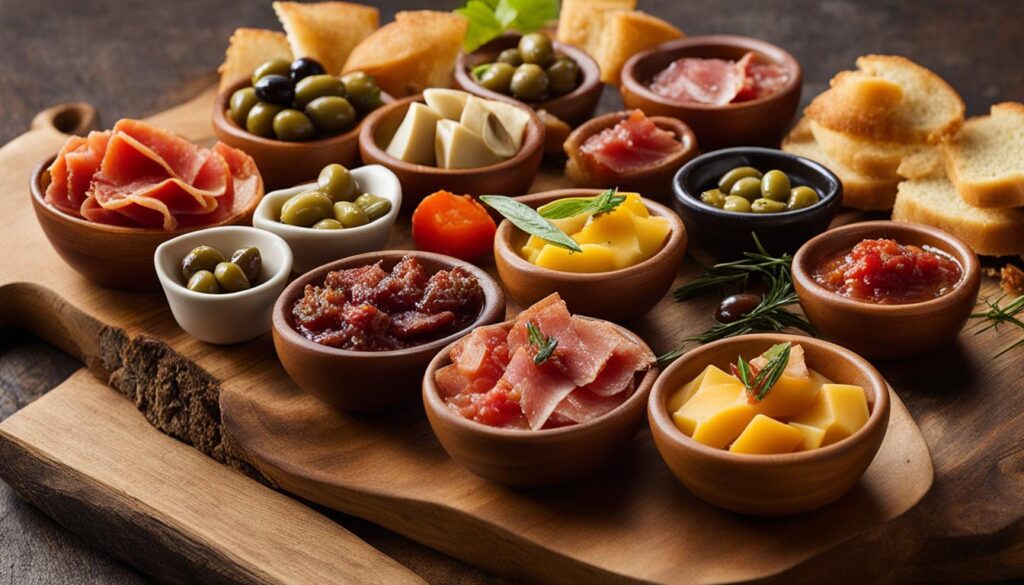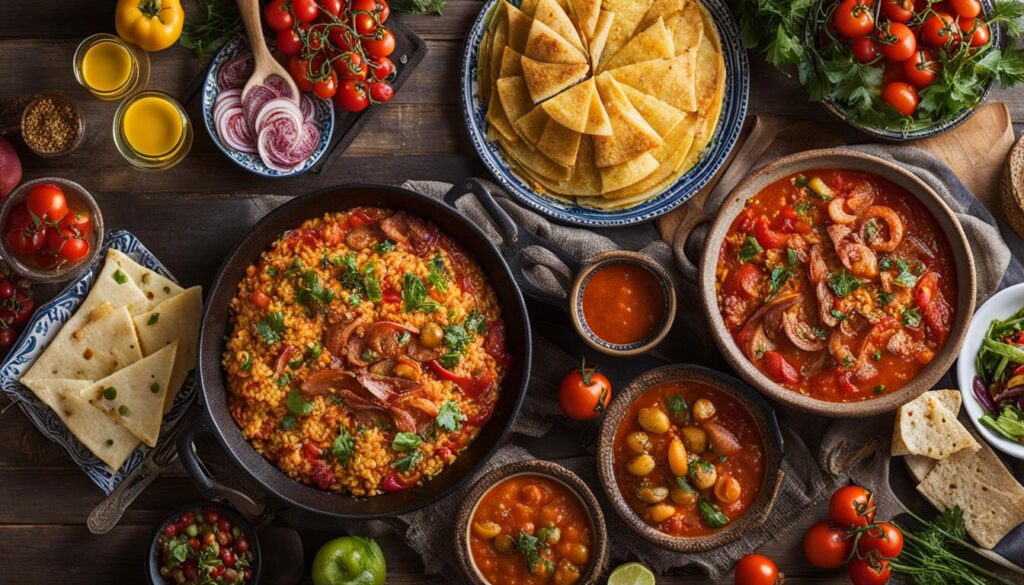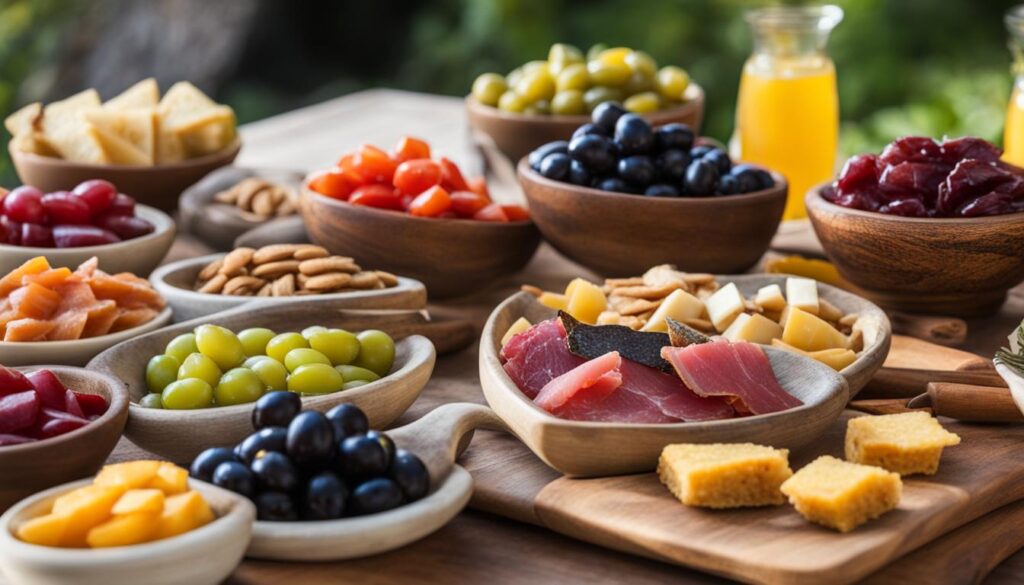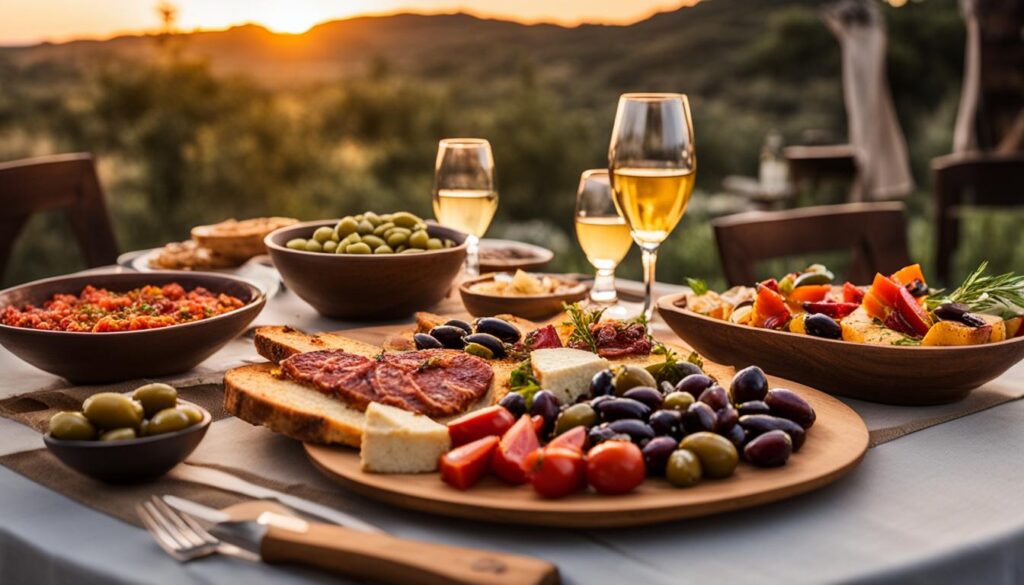Spain has a rich culinary heritage that dates back centuries. The traditional diets of Spain have evolved over time, reflecting the country’s diverse food culture. In this article, we will delve into the history of food in Spain and explore the past and present diets of the country, focusing on the traditional Spanish foods that have become iconic.
Key Takeaways:
- The traditional diets of Spain have evolved over time, reflecting the country’s diverse food culture.
- Breakfast in Spain is a relatively light meal, often consisting of café con leche, sweet rolls, or toast with jam.
- Tapas are a beloved part of Spanish cuisine, with a wide variety of small plates to choose from.
- Lunch is the largest and most important meal of the day in Spain, typically consisting of multiple courses.
- Spaniards enjoy a late afternoon snack known as “la merienda,” which serves as a bridge between lunch and dinner.
Breakfast, the Light Start to the Day
Breakfast, known as “el desayuno” in Spain, is a relatively light meal in comparison to lunch and dinner. A typical Spanish breakfast often includes café con leche (strong coffee with hot, frothy milk), sweet rolls called “bollos” with jam, toast with jam or mild cheese, or “Maria” crackers dunked in hot milk. Some popular breakfast items are sweet and lemony magdalenas, similar to French Madeleines. Breakfast is typically eaten at home before heading to work or school, although some workers may have a quick mid-morning coffee break at a local cafeteria.
Breakfast in Spain is a time for simplicity and ease, with an emphasis on quality ingredients. The combination of strong coffee and the sweet, buttery taste of bollos or magdalenas provides a satisfying start to the day. Toast with jam or mild cheese adds a touch of savoury flavour. The “Maria” crackers dipped in hot milk offer a comforting and familiar option, reminiscent of classic childhood breakfasts.
Spaniards understand the importance of fueling their bodies in the morning while keeping the meal light enough to maintain energy throughout the day. The simplicity of a Spanish breakfast reflects the country’s laid-back lifestyle and appreciation for enjoying each moment. Whether enjoyed at home or at a local café, breakfast in Spain sets the tone for a day filled with delicious food and shared experiences.
| Traditional Spanish Breakfast Foods | Description |
|---|---|
| Café con Leche | Strong coffee with hot, frothy milk |
| Bollos | Sweet rolls with jam |
| Toast | With jam or mild cheese |
| Maria Crackers | Dunked in hot milk |
| Magdalenas | Sweet and lemony muffins |
“Breakfast is the gentle awakening of the senses in Spain. The aroma of fresh coffee mingling with the sweetness of bollos and magdalenas creates a comforting and indulgent start to the day.” – Spanish Breakfast Enthusiast
Tapas, the Social Small Plates
Tapas are a beloved part of Spanish cuisine, offering a delightful and social way to enjoy a meal. These small plates, known for their variety and flavour, have become an integral part of Spanish food culture. Spaniards love to gather with friends and family to share tapas while enjoying wine or beer, creating a lively and convivial atmosphere.
Popular tapas in Spain vary from region to region, showcasing the diverse culinary traditions of the country. Some traditional tapas include a Spanish omelette, or tortilla Española, which is a hearty dish made with eggs and potatoes. Patatas bravas, fried potatoes with a spicy brava sauce, and gambas al ajillo, shrimp cooked in garlic sauce, are also popular choices.
“Vamos a tapear!” In Spain, this phrase is commonly used to invite friends to go eat tapas together, highlighting the importance of tapas in social gatherings.
Whether enjoyed in a bustling tapas bar or a cosy restaurant, the experience of eating tapas is an integral part of Spanish culture. It allows diners to sample an array of flavours, encouraging exploration and sharing of food. The communal nature of tapas brings people together, fostering connections and creating lasting memories.

Sample Tapas Menu
| Tapas | Description |
|---|---|
| Tortilla Española | A classic Spanish omelet made with eggs and potatoes |
| Patatas Bravas | Fried potatoes served with a spicy brava sauce |
| Gambas al Ajillo | Shrimp sautéed in garlic and olive oil |
| Jamon Serrano | Dry-cured Spanish ham, thinly sliced |
| Boquerones en Vinagre | Marinated anchovies |
| Pimientos de Padrón | Green peppers sautéed in olive oil and sprinkled with sea salt |
| Manchego Cheese | Aged Spanish cheese made from sheep’s milk |
Big Lunch, the Heart of the Day
Lunch, referred to as “la comida,” is the largest and most important meal of the day in Spain. It typically consists of multiple courses and is enjoyed at a leisurely pace. Spaniards believe in taking their time and savouring their meals. Traditional Spanish lunches often include a vegetable, bean, or seafood soup as the first course, followed by a main course of fresh fish or seafood, roast chicken or lamb, fried potatoes, or rabbit stew. A green salad or vegetables are served as a side dish, and desserts range from flan, a light pastry, to fresh fruit or ice cream. Lunch is accompanied by coffee and liqueur or brandy. Bread is always present on the Spanish table and is used to mop up sauces.
One characteristic feature of a traditional Spanish lunch is the concept of “menu del día” or “menu of the day.” Many restaurants, especially in larger cities, offer a fixed-price menu that includes a variety of options for each course. This allows diners to sample a range of dishes and experience the diversity of Spanish cuisine. The menus often change daily to reflect seasonal ingredients and the chef’s creativity.
To give you an idea of a typical Spanish lunch menu, here is an example:
| Course | Dish |
|---|---|
| First Course (Primer Plato) | Seafood Paella |
| Second Course (Segundo plato) | Roast Suckling Pig |
| Side Dish (Guarnición) | Patatas Bravas |
| Dessert (Postre) | Crema Catalana |
| Beverage (Bebida) | Red Wine |
This is just one example, and there are countless variations depending on the region and personal preferences. The important thing to remember is that a traditional Spanish lunch is a time for leisurely enjoyment and socializing with friends and family.

The Significance of Bread in Spanish Cuisine
Bread holds great significance in Spanish cuisine and is always present on the Spanish table during meals, including lunch. It is a symbol of sustenance and is used to mop up sauces or accompany dishes. In fact, the word “companion” in Spanish comes from the Latin “panis,” meaning bread. Spaniards appreciate the value of good bread and often visit local bakeries to buy fresh loaves or rolls to enjoy with their meals.
Traditional Spanish bread is typically made with wheat flour, water, yeast, and salt. It has a crusty exterior and a soft, chewy interior. There are many regional variations, each with its own unique flavour and texture. Some popular types of Spanish bread include baguettes, ficelles, and rustic country loaves.
In summary, the big lunch is the heart of the day in Spain, where Spaniards take their time to enjoy a variety of courses and savour the flavour of traditional Spanish cuisine. With its emphasis on fresh ingredients, the lunchtime experience offers a true taste of Spain’s rich culinary heritage.
Afternoon Snack, the Bridge to Dinner
In Spain, the late afternoon snack is known as “la merienda” and serves as a bridge between lunch and dinner. This snack is especially important for children, who have several hours between lunch and dinner. La merienda can consist of a piece of bread topped with chocolate or chorizo sausage, ham, or salami. It is usually enjoyed around 4:30 or 5 p.m. without the worry of ruining the appetite for dinner.
In the Spanish culture, the afternoon snack is a time for relaxation and indulgence. Families and friends gather to share a moment together and enjoy a small treat before dinner. It is common to see children coming home from school and eagerly looking forward to their merienda, which can be a simple yet satisfying combination of flavours.
This tradition of an afternoon snack not only provides sustenance but also allows for a pause in the day’s activities. It serves as a way to recharge and refuel before continuing with the evening. Whether it’s a quick bite on the go or a more leisurely affair, the merienda offers a moment of pleasure and connection.

Traditional Spanish Snacks
| Snack | Description |
|---|---|
| Churros con Chocolate | Fried dough pastry sprinkled with sugar, served with thick hot chocolate |
| Jamon Serrano | Cured Spanish ham, thinly sliced and often enjoyed with bread |
| Empanadas | Savoury turnovers filled with meat, vegetables, or cheese |
| Tortilla de Patatas | Spanish omelette made with potatoes and eggs, served at room temperature |
| Pan con Tomate | Toasted bread rubbed with ripe tomatoes, garlic, and olive oil |
| Pinchos | Skewered bite-sized snacks topped with various ingredients |
These are just a few examples of the wide variety of traditional Spanish snacks. Each region of Spain has its own specialities and variations, making the exploration of Spanish snacks a delightful adventure.
Light Dinner, the Evening Meal
Dinner, referred to as “la cena,” is a lighter meal compared to lunch and is usually eaten between 9 p.m. and midnight. Dinner portions are typically smaller, and the dishes are simpler. Fresh fish or seafood, roast chicken or lamb with fried potatoes or rice, an omelette and fish with a green salad on the side are common choices for dinner. A lighter dessert of fresh fruit or flan, a Spanish vanilla custard, may also be enjoyed. Instead of sitting down at a restaurant, friends may meet at their favourite tapas bars before going to a movie or heading to a club.

Spanish dinner dishes are known for their simplicity and emphasis on fresh ingredients. The focus is on quality rather than quantity, with smaller portions allowing for a more leisurely dining experience. The cuisine varies depending on the region, with coastal areas offering an abundance of seafood, while inland regions showcase dishes like roast chicken or lamb.
Traditional Spanish Dinner Menu
- Starters: Gazpacho (cold tomato soup), Jamón Ibérico (cured ham), or Manchego cheese.
- Main Course: Paella (rice dish with seafood or meat), Bacalao a la Vizcaína (Basque-style cod), or Pollo al Ajillo (garlic chicken).
- Side Dish: Patatas Bravas (fried potatoes with spicy sauce) or Ensalada Mixta (mixed salad).
- Dessert: Flan (caramel custard), Tarta de Santiago (almond cake), or Crema Catalana (Catalan cream).
- Beverages: Red or white wine, Sangria, or a refreshing glass of Horchata (tiger nut milk).
These are just a few examples of the diverse range of dishes that can be found on a traditional Spanish dinner menu. The emphasis on fresh, seasonal ingredients and simple preparation allows the natural flavours to shine through, resulting in a satisfying and memorable dining experience.
Nightlife Indulgence: The Perfect End to the Day
Spaniards are renowned for their vibrant nightlife, making it an integral part of the country’s culture. After dinner, locals continue the festivities by socializing in neighborhood cafés, taverns, or heading to nightclubs and pubs. This bustling atmosphere offers a variety of late-night activities for everyone to enjoy.
One popular indulgence during Spanish nighttime is stopping by a churro stand. These delicious pastries are made from dough that is freshly fried to perfection and sprinkled with sugar on top. Paired with traditional thick, sweet hot chocolate made from fresh, whole milk, churros create a delectable combination that is hard to resist. This iconic treat is a staple in Spanish culinary traditions.
To fully experience Spanish nightlife, locals and tourists alike often venture out to enjoy the lively atmosphere of cafés and taverns. These establishments provide the perfect setting to relax, socialize, and immerse oneself in the vibrant energy of the Spanish night. Whether enjoying a drink with friends, soaking in the lively ambience, or trying unique cocktails, Spanish nightlife has something for everyone.
Traditional Spanish Night Activities
- Socializing in neighborhood cafés and taverns
- Visiting nightclubs or pubs
- Stopping by churro stands for a late-night snack
- Enjoying the lively atmosphere of cafés and taverns
Spanish Churros and Chocolate
“Churros and hot chocolate are the ideal way to end a day in Spain. The crispiness of the churros combined with the rich, thick hot chocolate creates a truly indulgent experience.” – Spanish culinary expert

| Activity | Description |
|---|---|
| Socializing in neighborhood cafés and taverns | Locals and tourists gather in these establishments to enjoy drinks, conversation, and the vibrant nighttime atmosphere. |
| Visiting nightclubs or pubs | Spaniards love to dance and have a good time, making nightclubs and pubs popular destinations for those seeking live music and a lively ambience. |
| Stopping by churro stands for a late-night snack | Churros, delicious fried pastries, are often enjoyed late at night, accompanied by a cup of thick, sweet hot chocolate. |
| Enjoying the lively atmosphere of cafés and taverns | The bustling environment of cafés and taverns provides an opportunity to relax, socialize, and soak in the vibrant energy of Spanish nightlife. |
Historical Context of Spanish Diets
Over the centuries, the diets of the people in Spain have been shaped by historical events and cultural exchanges. One fascinating period that influenced Spanish diets was the Middle Ages. During this time, Christians and Muslims coexisted in the Iberian Peninsula, and their diets differed due to cultural and religious preferences. Analyzing stable isotopes in human and animal bone collagen from the Middle Ages has revealed significant disparities in the diets of Christians and Muslims, highlighting differences in access to food sources.
The intermingling of faiths in medieval Spain, known as convivencia, had a profound impact on the culinary traditions of the country. The distinctive flavours and ingredients from Islamic cuisine, such as saffron, almonds, and rice, became integrated into Spanish cooking. Moreover, the Islamic influence expanded cultivation practices, introducing new crops like citrus fruits, apricots, and sugar cane. These culinary exchanges between Christians and Muslims contributed to the development of the unique and diverse food culture we see in Spain today.
During the Middle Ages, Christians and Muslims lived side by side in the Iberian Peninsula, and their diets differed due to cultural and religious preferences.
Besides the Middle Ages, Spanish diets were also shaped by the colonial era and the colonization of the Americas. The influx of new foods and ingredients from the New World had a transformative effect on European diets, including the Spanish diet. Early European settlers in the Americas faced the challenge of adapting to a different environment, and food played a crucial role in defining the categories of “Spaniards” and “Indians.” The fusion of European and indigenous diets during the colonial era resulted in a culinary exchange that brought new flavours, ingredients, and cooking techniques to Spain.
The historical context of Spanish diets provides a deeper understanding of how the country’s culinary traditions have evolved. From the cultural exchanges during the Middle Ages to the fusion of European and indigenous cuisines in the colonial era, the history of Spanish diets is a testament to the rich and dynamic food culture of the country.

Table: Contrasting Characteristics of Spanish Diets in the Middle Ages
| Characteristic | Christian Diet | Muslim Diet |
|---|---|---|
| Meat Consumption | Primarily pork and beef | Limited to halal meat (e.g., lamb) |
| Spices | Minimal use | Extensive use of spices like saffron, cinnamon, and cumin |
| Ingredients | Focus on grains, vegetables, and legumes | Emphasis on rice, almonds, and dried fruit |
| Cooking Techniques | Roasting, boiling, and stewing | Complex cooking methods like elaborate braising and the use of fragrant oils |
Colonial Influence on Spanish Diets
The colonization of the Americas by European powers, including Spain, had a profound impact on the diets and food culture of the region. As European settlers ventured into the New World, they encountered unfamiliar foods and a different environment, which necessitated adaptations in their diets. The influence of the New World environment on European diets cannot be overstated, as it introduced a wide variety of new foods such as tomatoes, potatoes, corn, chocolate, and chilli peppers.

The arrival of these new ingredients transformed Spanish cuisine, leading to a fusion of flavours and the creation of dishes that are now considered iconic in both Spain and Latin America. For example, the introduction of tomatoes and chilli peppers gave rise to salsa, a staple condiment in many Spanish dishes. The incorporation of potatoes into Spanish cuisine resulted in beloved dishes like patatas bravas and Spanish omelette (tortilla Española).
Additionally, the colonization of the Americas brought about changes in the way food was cultivated and consumed. European settlers introduced new agricultural practices and crops to the region, which not only impacted Spanish diets but also influenced the diets of indigenous populations. This interchange of culinary traditions and ingredients between Europe and the Americas shaped the development of Spanish cuisine and created a unique blend of flavours that continues to be celebrated today.
Conclusion
The diets of Spain, both past and present, encompass a vibrant culinary heritage that showcases the country’s diverse food culture. Spaniards have a unique relationship with food, demonstrated through their various meals and eating traditions. From the light and simple breakfast to the indulgence of tapas and the heartiness of lunch, food holds a central place in the lives of Spaniards.
Historical influences have played a significant role in shaping Spanish diets. The Middle Ages saw cultural and religious differences influencing the diets of Christians and Muslims in the Iberian Peninsula. The intermingling of faiths in medieval Spain, known as convivencia, resulted in a blend of culinary traditions that have endured to this day.
Furthermore, the colonial era brought about a fusion of flavours as European settlers in the New World adapted to different environments and incorporated indigenous foods into their diets. This fusion of culinary influences has enriched Spanish cuisine, creating a unique and diverse food culture that continues to thrive.
The past and present diets of Spain are not merely about the act of eating but reflect the importance of food in socializing and celebrating life. Spaniards’ love for good food is ingrained in their cultural identity, and their culinary traditions serve as a testament to their rich history and vibrant food culture. The traditional Spanish foods and dining customs continue to be cherished, providing a delicious glimpse into the heart and soul of this fascinating country.
FAQ
What is a typical Spanish breakfast?
A typical Spanish breakfast includes café con leche (strong coffee with hot, frothy milk), sweet rolls called “bollos” with jam, toast with jam or mild cheese, or “Maria” crackers dunked in hot milk. Some popular breakfast items are sweet and lemony magdalenas, similar to French Madeleines.
What are tapas in Spanish cuisine?
Tapas are small plates of canapés or finger food that vary greatly from region to region and season to season. Some popular tapas include Spanish omelet, or tortilla Española, potatoes with spicy brava sauce known as patatas bravas, and shrimp in garlic sauce called gambas al ajillo.
What is a traditional Spanish lunch like?
A traditional Spanish lunch consists of multiple courses and is enjoyed at a leisurely pace. It often includes a vegetable, bean, or seafood soup as the first course, followed by a main course of fresh fish or seafood, roast chicken or lamb, fried potatoes, or rabbit stew. A green salad or vegetables are served as a side dish, and desserts range from flan to fresh fruit or ice cream.
What is a typical Spanish afternoon snack?
A typical Spanish afternoon snack, known as “la merienda,” can consist of a piece of bread topped with chocolate or chorizo sausage, ham, or salami. It is usually enjoyed around 4:30 or 5 p.m. without the worry of ruining the appetite for dinner.
What is a traditional Spanish dinner?
A traditional Spanish dinner is a lighter meal compared to lunch. It typically includes dishes such as fresh fish or seafood, roast chicken or lamb with fried potatoes or rice, an omelette, and fish with a green salad on the side. A lighter dessert of fresh fruit or flan, a Spanish vanilla custard, may also be enjoyed.
What is a popular late-night indulgence in Spain?
A popular late-night indulgence in Spain is stopping at a churro stand to enjoy freshly fried pastries made from dough with sugar sprinkled on top. Churros are often accompanied by hot chocolate, which is thick, sweet, and made from fresh, whole milk.
How have historical events shaped the diets of Spain?
Historical events, such as the intermingling of faiths during the Middle Ages in Spain, known as convivencia, and the colonization of the Americas by European powers, including Spain, have had a significant impact on the culinary traditions and fusion of flavours in Spanish diets.
What influence did the colonial era have on Spanish diets?
The colonization of the Americas brought about significant changes in diets and food culture. Early European settlers faced challenges adapting to different environments, including new foods and climate. Food played a crucial role in shaping the categories of “Spaniard” and “Indian” and resulted in a fusion of culinary influences.
What is the significance of Spanish diets in the past and present?
The diets of the people in Spain reflect a rich culinary heritage and diverse food culture. Spaniards have a unique relationship with food, enjoying light breakfasts, social tapas, hearty lunches, afternoon snacks, and lighter dinners. Traditional Spanish foods have been influenced by historical events and the colonial era, resulting in a fusion of flavours and international culinary traditions.
Source Links
- https://www.thespruceeats.com/meals-and-the-culture-of-spain-3083066
- https://academic.oup.com/ahr/article/115/3/688/41267
- https://www.ncbi.nlm.nih.gov/pmc/articles/PMC4303993/
Explore More About Spain and Its Regions Here:
| Past and Present Diets of Southern Europe |
| Past and Present Diets of Mediterranean |



